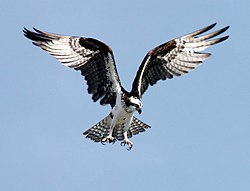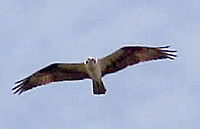Difference between revisions of "Field Guide/Birds/Pandion haliaetus"
| Line 15: | Line 15: | ||
The '''Osprey''' (''Pandion haliaetus'') is a medium large [[bird of prey|raptor]] which is a specialist fish-eater with a worldwide distribution. It is often known by other [[colloquial]] names such as '''Fish Hawk''', '''Sea Hawk''' or '''Fish Eagle'''. It is the only member of the genus ''Pandion'' , which is in turn the only genus in family Pandionidae. | The '''Osprey''' (''Pandion haliaetus'') is a medium large [[bird of prey|raptor]] which is a specialist fish-eater with a worldwide distribution. It is often known by other [[colloquial]] names such as '''Fish Hawk''', '''Sea Hawk''' or '''Fish Eagle'''. It is the only member of the genus ''Pandion'' , which is in turn the only genus in family Pandionidae. | ||
| − | The Osprey is 52-60cm (20.5-23.6 inches) long with a 152-167cm wingspan. It has white underparts and long, narrow wings with four "finger" feathers at the end of each, which give it a very distinctive appearance. | + | The Osprey is 52-60cm (20.5-23.6 inches) long with a 152-167cm (5-5.5 feet) wingspan. It has white underparts and long, narrow wings with four "finger" feathers at the end of each, which give it a very distinctive appearance. |
Their call is a series of sharp, whistles, ''cheep'', ''cheep'', or ''yewk'', ''yewk''. Near the nest, a frenzied ''cheereek''! | Their call is a series of sharp, whistles, ''cheep'', ''cheep'', or ''yewk'', ''yewk''. Near the nest, a frenzied ''cheereek''! | ||
Revision as of 21:11, 23 January 2006
Template:Otheruses
Template:Taxobox begin
Template:Taxobox image
Template:Taxobox begin placement
Template:Taxobox regnum entry
Template:Taxobox phylum entry
Template:Taxobox classis entry
Template:Taxobox ordo entry
Template:Taxobox familia entry
Template:Taxobox authority
Template:Taxobox genus entry
Template:Taxobox authority
Template:Taxobox species entry
Template:Taxobox end placement
Template:Taxobox section binomial parens
Template:Taxobox end
The Osprey (Pandion haliaetus) is a medium large raptor which is a specialist fish-eater with a worldwide distribution. It is often known by other colloquial names such as Fish Hawk, Sea Hawk or Fish Eagle. It is the only member of the genus Pandion , which is in turn the only genus in family Pandionidae.
The Osprey is 52-60cm (20.5-23.6 inches) long with a 152-167cm (5-5.5 feet) wingspan. It has white underparts and long, narrow wings with four "finger" feathers at the end of each, which give it a very distinctive appearance.
Their call is a series of sharp, whistles, cheep, cheep, or yewk, yewk. Near the nest, a frenzied cheereek!
The Osprey is particularly well adapted to its diet, with reversible outer toes, closable nostrils to keep out water during dives, and backwards facing scales on the talons which act as barbs to help catch fish.
It locates its prey from the air, often hovering prior to plunging feet-first into the water to seize a fish. As it rises back into flight the fish is turned head forward to reduce drag. The 'barbed' talons are such effective tools for grasping fish that, on occasion, an Osprey may be unable to release a fish that is heavier than expected. This can cause the Osprey to be pulled into the water, where it may either swim to safety or catch hypothermia and drown.
It breeds by freshwater lakes, and sometimes on coastal brackish waters. The nest is a large heap of sticks built in trees, rocky outcrops, telephone poles or artificial platforms. In some regions with high Osprey densities, such as Chesapeake Bay, USA, most Ospreys do not start breeding until they are five to seven years old. Many of the structures they need to build nests on are already taken. If there are no nesting sites available, young Ospreys may be forced to delay breeding.
Ospreys usually mate for life. In March or earlier depending on region, they begin a five-month period of partnership to raise their young. Females lay 3–4 eggs by late April, and rely on the size of their nest to help conserve heat. The eggs are approximately the size of chicken eggs, and cinnamon colored. The eggs generally incubate for 5 weeks. After hatching, 2-ounce chicks become fliers within eight weeks. When food is scarce, the first chicks to hatch are most likely to survive. The typical lifespan is 20-25 years.
European breeders winter in Africa. American and Canadian breeders winter in South America, although some stay in the southernmost USA states such as Florida and California. Australasian Ospreys tend not to migrate.
The Osprey is the official bird of Nova Scotia in Canada and Sudermannia in Sweden.
The Osprey differs in several respects from the other diurnal birds of prey, and has always presented something of a riddle to the taxonomist. Here it is treated as the sole member of the family Pandionidae, and the family listed in its traditional place as part of the order Falconiformes. Other schemes place it alongside the hawks and eagles in the family Accipitridae—which itself can be regarded as making up the bulk of the order Accipitriformes or else be lumped with the Falconidae into Falconiformes— and others again group it alongside the other raptors in a greatly enlarged Ciconiiformes.
Twenty to thirty years ago, Ospreys in some regions faced possible extinction, because the species could not produce enough young to maintain the population. Since the ban of DDT in many countries in the early 1970s, together with reduced persecution, the Ospreys, as well as other affected bird of prey species are making significant recoveries.
The Osprey was depicted on the 1986 series Canadian $10 note.
External links
Template:Commons Template:En:wiktionary
- RSPB UK Osprey Diary with links to much other bird information
- For numerous links to information about ospreys in Britain.
- A little about ospreys in West Virginia
af:Visarend bg:Орел рибар cs:Orlovec říční cy:Gwalch y Pysgod da:Fiskeørn de:Fischadler eo:Fiŝaglo fr:Balbuzard pêcheur fy:Fiskearn gl:Aguia peixeira io:Maraglo he:שלך lt:Erelis žuvininkas nl:Visarend ja:ミサゴ nn:Fiskeørn pl:Rybołów pt:Águia-pesqueira sl:Ribji orel fi:Sääksi sv:Fiskgjuse tr:Balık kartalı zh:鹗


